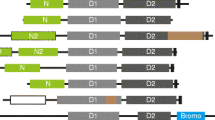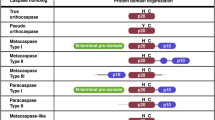Abstract.
The AAA proteins (ATPases Associated with a variety of cellular Activities) are found in eubacterial, archaebacterial, and eukaryotic species and participate in a large number of cellular processes, including protein degradation, vesicle fusion, cell cycle control, and cellular secretory processes. The AAA proteins are characterized by the presence of a 230 to 250-amino acid ATPase domain referred to as the Conserved ATPase Domain or CAD. Phylogenetic analysis of 133 CAD sequences from 38 species reveal that AAA CADs are organized into discrete groups that are related not only in structure but in cellular function. Evolutionary analyses also indicate that the CAD was present in the last common ancestor of eubacteria, archaebacteria, and eukaryotes. The eubacterial CADs are found in metalloproteases, while CAD-containing proteins in the archaebacterial and eukaryotic lineages appear to have diversified by a series of gene duplication events that lead to the establishment of different functional AAA proteins, including proteasomal regulatory, NSF/Sec, and Pas proteins. The phylogeny of the CADs provides the basis for establishing the patterns of evolutionary change that characterize the AAA proteins.
Similar content being viewed by others
Author information
Authors and Affiliations
Additional information
Received: 28 January 1997 / Accepted: 8 May 1997
Rights and permissions
About this article
Cite this article
Swaffield, J., Purugganan, M. The Evolution of the Conserved ATPase Domain (CAD): Reconstructing the History of an Ancient Protein Module. J Mol Evol 45, 549–563 (1997). https://doi.org/10.1007/PL00006259
Issue Date:
DOI: https://doi.org/10.1007/PL00006259




